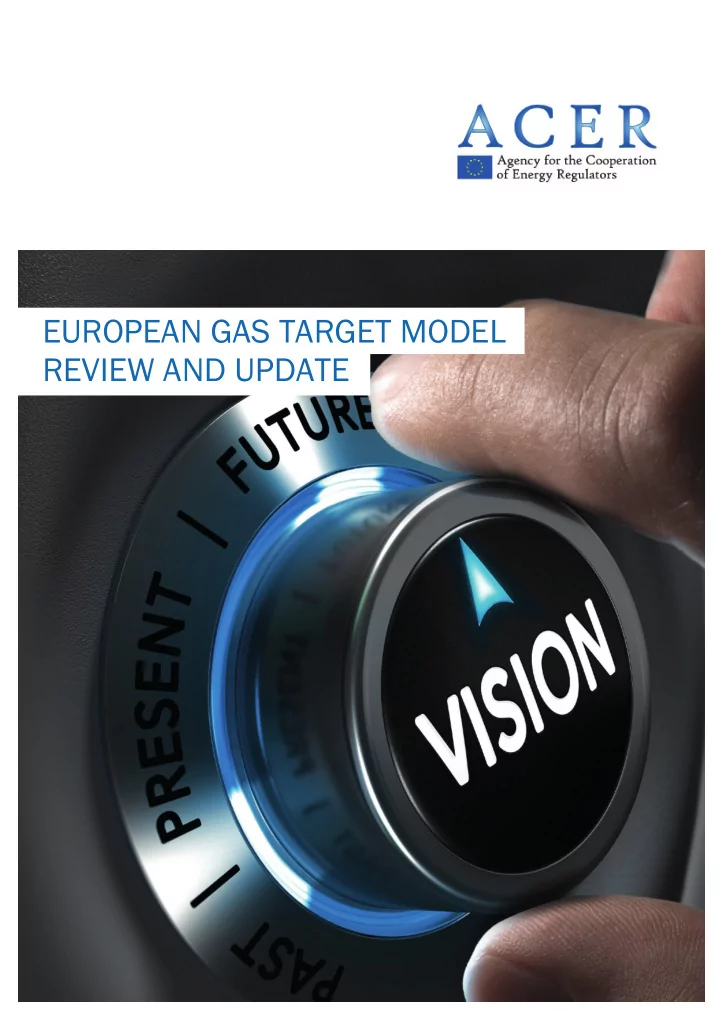

EUROPEAN GAS TARGET MODEL REVIEW AND UPDATE
European Gas Target Model review and update January 2015 Agency for the Cooperation of Energy Regulators Trg Republike 3 Ljubljana - Slovenia
European Gas Target Model – Review and update Table of Contents EXECUTIVE SUMMARY ........................................................................................................ 4 1 INTRODUCTION ............................................................................................................. 7 1.1 The “Bridge to 2025” and Gas Target Model 7 ............................................................. 1.2 Background .............................................................................................................. 7 1.3 Process .................................................................................................................... 8 1.4 Content ..................................................................................................................... 8 2 CONTEXT ...................................................................................................................... 10 2.1 Demand .................................................................................................................. 10 2.2 Supply .................................................................................................................... 12 2.3 Conclusions from demand and supply trends ......................................................... 13 2.4 Gas market vision and European-wide Network Codes .......................................... 14 3 SECURITY OF SUPPLY AND UPSTREAM COMPETITION ......................................... 15 3.1 Introduction ............................................................................................................. 15 3.2 Status quo .............................................................................................................. 15 3.3 Recommendations .................................................................................................. 16 4 WHOLESALE MARKET FUNCTIONING ...................................................................... 20 4.1 Objective ................................................................................................................ 20 4.2 Defining new criteria to assess the functioning of wholesale markets ..................... 20 4.3 The status quo – assessing the functioning of European wholesale markets .......... 23 4.4 The self-evaluation process .................................................................................... 25 4.5 Unable to meet GTM 2014 criteria .......................................................................... 26 4.6 Conclusions ............................................................................................................ 27 5 THE ROLE OF GAS IN COMPLEMENTING RES ELECTRICITY GENERATION ........ 28 5.1 Objective ................................................................................................................ 28 5.2 Status quo .............................................................................................................. 28 5.3 Recommendations .................................................................................................. 29 6 NEW DEVELOPMENTS ALONG THE GAS SUPPLY CHAIN ...................................... 31 6.1 New developments: brief description of the technologies and their presence in the EU ............................................................................................................................... 31 6.2 Growth forecast ...................................................................................................... 34 6.3 EU regulation that may influence the growth of the new developments ................... 34 6.4 ACER and NRAs positions and recommendations.................................................. 35 2/43
European Gas Target Model – Review and update ANNEXES ............................................................................................................................ 37 ANNEX 1: ACER ................................................................................................................. 37 ANNEX 2: GLOSSARY AND ABBREVIATIONS ................................................................. 37 ANNEX 3: CALCULATION SPECIFICATION FOR WHOLESALE MARKET METRICS ..... 38 ANNEX 4: STAKEHOLDER REQUIREMENTS ON GAS FORWARD MARKETS: RESULTS FROM THE 2014 MARKET INQUIRY .................................................................................. 38 ANNEX 5: METRICS FOR MARKET PARTICIPANTS’ NEEDS: RESULTS FOR SELECTED EUROPEAN GAS MARKETS .......................................................................... 38 38 ANNEX 6: DESCRIPTION OF MARKET INTEGRATION TOOLS ....................................... ANNEX 7: BRIEF DESCRIPTION OF ONGOING CROSS-BORDER MARKET INTEGRATION PROJECTS ................................................................................................. 38 ANNEX 8: BEST PRACTICE IN GAS MARKET DESIGN ................................................... 42 3/43
European Gas Target Model – Review and update Executive summary Our vision: a competitive, secure European gas market that benefits all consumers In the “Bridge to 2025”, regulators set out their thinking on the key challenges and the possible responses to secure the appropriate regulatory framework for the coming decade. The present document renews and updates the Gas Target Model (GTM) developed in 2011. The core principles that underpin our vision for European gas markets will remain the same today as when the GTM was first published. This vision is of a competitive European gas market, comprising entry-exit zones with liquid virtual trading points, where market integration is served by appropriate levels of infrastructure, which is utilised efficiently and enables gas to move freely between market areas to the locations where it is most highly valued by gas market participants. However, the European gas market and the uncertainties and challenges it faces have changed fundamentally, and this requires a new mind set in order to adopt the correct regulatory approach when looking forward to the next decade. The Network Codes will bring Europe closer to this vision. Implementing them in full and on schedule is the right priority and the focus for regulators and other stakeholders today. However, the Network Codes alone are unlikely to deliver a “well-functioning transparent gas wholesale … market” that benefits consumers across Europe, as required by Regulation (EC) No 715/2009 1 . Consequently, this revised GTM not only guides the coherent development and implementation of the Network Codes, but also specifies the steps required to realise liquid and dynamic gas markets thereby enabling all European consumers to benefit from secure gas supplies and effective retail competition. Increasing uncertainty in supply and demand An important factor in revising the GTM has been changing gas market dynamics. The supply and demand picture has become increasingly uncertain in recent years. For a long period, gas demand had been rising relentlessly. A combination of factors has changed that. In particular, the shale gas revolution in America has put gas-intensive European industrial enterprises at a competitive disadvantage. At the same time, the coal displaced from the American generation mix has lowered coal prices in Europe such that coal-fired generation is now far more profitable than running gas-fired power stations. The low emission allowance price has also exacerbated this phenomenon. On the supply side, European Union (EU) production, which is located largely in the UK and the Netherlands, is declining. Whilst unconventional gas production will be a positive development as far as domestic output is concerned, it is unlikely to have a significant impact on gas supplies, even in the most optimistic scenarios, until well into the 2020s. Competitive markets ensure Security of Supply Security of Supply and competition work in concert; the more pluralistic upstream supply is in Europe, the less we will depend on any one source of supply that may be subject to either physical restrictions or political interference. Our research shows that thirteen Member States do not meet the original GTM target of a Residual Supply Index (RSI) of over 110% of demand, whilst most Eastern European countries cannot currently hit this target. The GTM strongly affirms that well-functioning gas markets remain essential providers of supply security. Building on the original GTM, we recommend further enhancements to market-based measures, such as 1 See Regulation (EC) No 715/2009 on conditions for access to the natural gas transmission networks, http://eur- lex.europa.eu/LexUriServ/LexUriServ.do?uri=OJ:L:2009:211:0036:0054:en:PDF 4/43
Recommend
More recommend